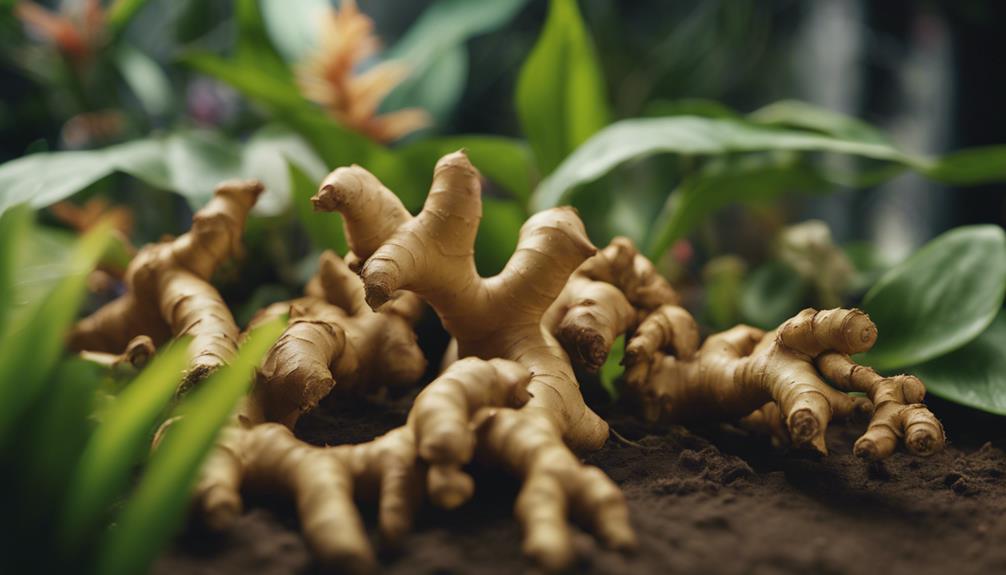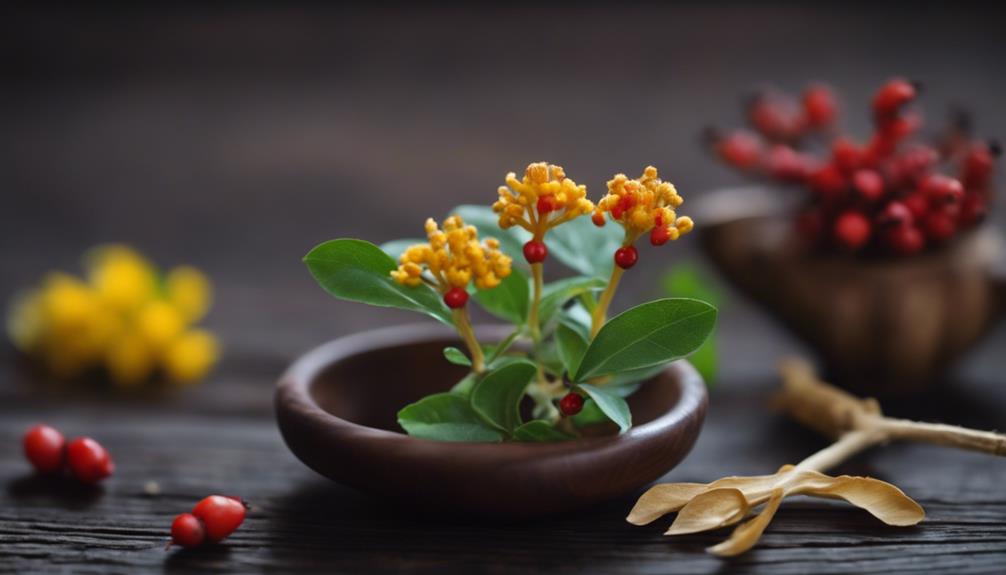When it comes to natural pain relief, turmeric, ginger, and peppermint are our top choices for potent analgesic properties. Turmeric's active compound, curcumin, acts as a natural painkiller by reducing inflammation and offering antioxidant benefits. Ginger, with its gingerol content, effectively reduces muscle pain, soreness, and even symptoms of osteoarthritis. Peppermint, known for its menthol content, provides cooling pain relief by blocking pain signals and reducing pain sensitivity over time. These plants offer versatile and holistic pain management options for those seeking natural remedies.
Key Takeaways
- Turmeric's curcumin offers potent pain relief through anti-inflammatory and antioxidant properties.
- Ginger's gingerol acts as a natural analgesic, reducing muscle pain, arthritis symptoms, and migraines.
- Peppermint's menthol provides cooling pain relief by blocking pain signals and reducing sensitivity over time.
Turmeric: Potent Pain Relief
We find turmeric to be a potent pain reliever due to its active compound curcumin known for its anti-inflammatory properties. Curcumin, found in turmeric, acts as a natural analgesic by reducing inflammation, making it effective in alleviating joint pain, arthritis, and various inflammatory conditions.
The antioxidant properties of turmeric further enhance its pain-relieving abilities, providing a holistic approach to managing discomfort. Centuries of traditional medicine have recognized turmeric for its healing properties, attributing its efficacy in pain relief to its analgesic effects.
Incorporating turmeric into your daily routine, whether through culinary uses or supplements, can offer a natural alternative for pain management. The anti-inflammatory nature of curcumin not only targets pain symptoms but also addresses the underlying causes, promoting overall well-being.
Embracing turmeric as a natural painkiller can provide relief without the potential side effects associated with conventional medications, making it a valuable addition to a health-conscious lifestyle.
Ginger: Natural Analgesic

How does ginger serve as a natural analgesic for pain relief?
Ginger contains bioactive compounds like gingerol, known for their potent anti-inflammatory and analgesic properties. These properties make ginger an effective natural painkiller, particularly in reducing muscle pain and soreness.
Studies have indicated that regular consumption of ginger can help alleviate symptoms of conditions like osteoarthritis by decreasing pain and enhancing mobility.
The anti-inflammatory effects of ginger extend to providing relief for menstrual pain and migraines as well.
Whether consumed fresh, in powdered form, or as a supplement, ginger contributes to natural pain relief due to its diverse range of applications.
Its ability to target various types of pain, coupled with its anti-inflammatory nature, positions ginger as a versatile and accessible option for those seeking natural alternatives for pain management.
Peppermint: Cooling Pain Reliever

Peppermint stands out as a cooling pain reliever due to its unique ability to provide relief through its menthol content, which acts as a natural painkiller by blocking pain signals.
When applied topically, peppermint oil offers an invigorating cooling sensation that can help alleviate various types of discomfort, including headaches, muscle aches, and joint pain.
The menthol in peppermint not only provides immediate relief but also has been shown to reduce pain sensitivity over time. Studies support the analgesic properties of peppermint, making it a popular choice for those seeking natural pain management options.
By targeting pain at the source and offering a soothing effect, peppermint serves as a versatile remedy for individuals looking to address their pain in a more holistic manner.
Whether used alone or in combination with other natural pain relievers, peppermint continues to be a go-to solution for those seeking relief from various forms of discomfort.
Frequently Asked Questions
What Is the Strongest Natural Painkiller?
We believe wild lettuce is one of the strongest natural painkillers due to its pain-relieving properties. Lactucarium in wild lettuce contains compounds like lactucin and lactucopicrin, potentially offering pain relief comparable to ibuprofen.
What Plant Is the Best Pain Killer?
We believe wild lettuce stands out as a potential natural painkiller plant. Its lactucarium contains properties akin to ibuprofen. While research on its efficacy is limited, some components show anti-inflammatory effects, contributing to pain relief.
What Is the Strongest Herb for Nerve Pain?
For nerve pain relief, Wild Lettuce is a popular choice. Its lactucarium contains compounds that may help alleviate discomfort. More human studies are necessary to confirm its efficacy conclusively, but animal research looks promising.
Which Plant Is Traditionally Used as a Pain Reliever?
Wild Lettuce, traditionally used as a pain reliever, contains compounds that act on the central nervous system for relief. While research is limited, caution is advised due to potential side effects and lack of FDA regulation.
Conclusion
To sum up, turmeric, ginger, and peppermint stand as formidable allies in the battle against pain. Like a trio of skilled warriors, these natural painkiller plants offer potent relief without the harsh side effects of pharmaceuticals.
Turmeric's powerful anti-inflammatory properties, ginger's natural analgesic qualities, and peppermint's cooling sensation make them invaluable tools in the fight against discomfort. Incorporating these plants into your wellness routine can help you conquer pain and regain control of your health.










